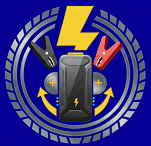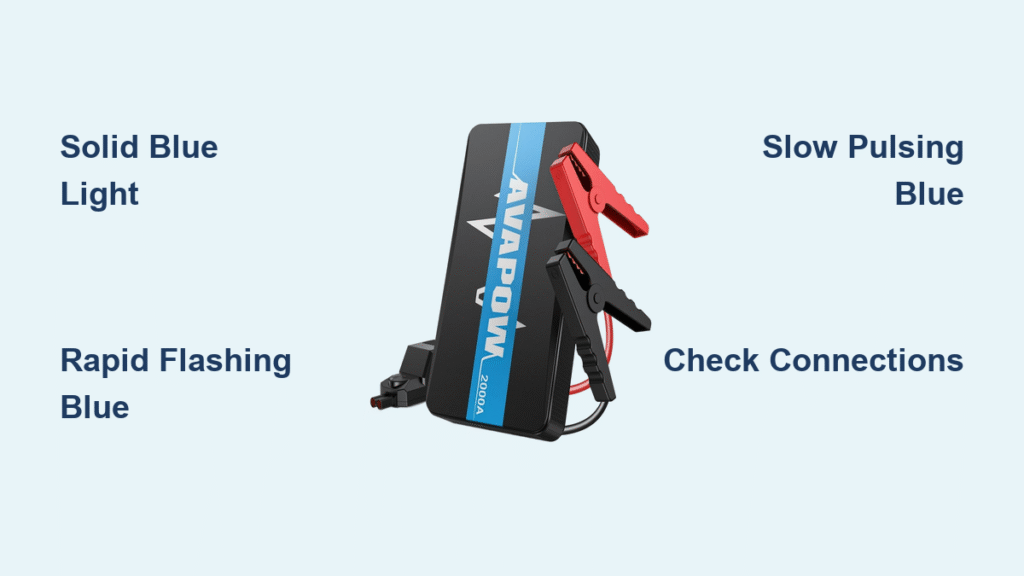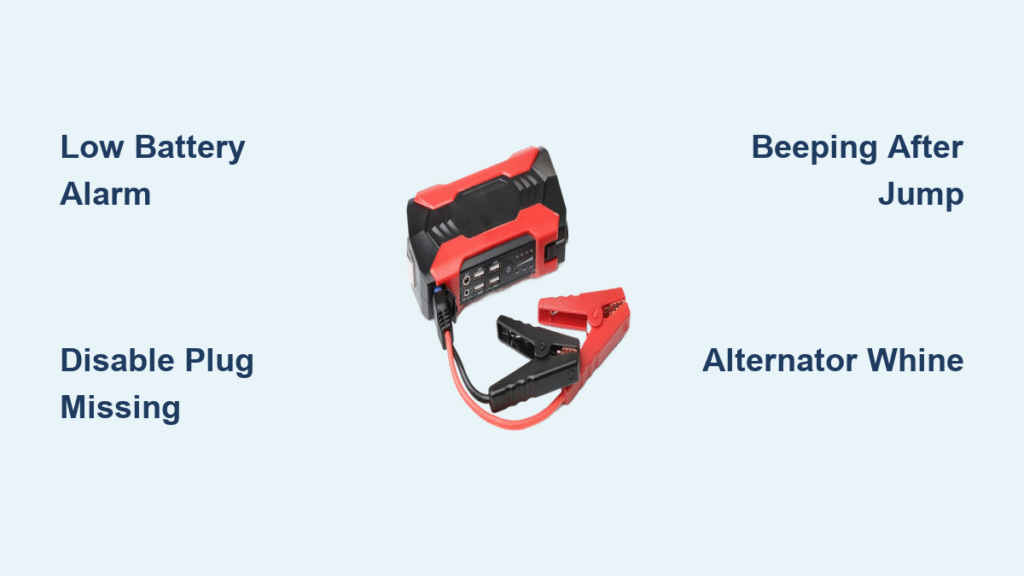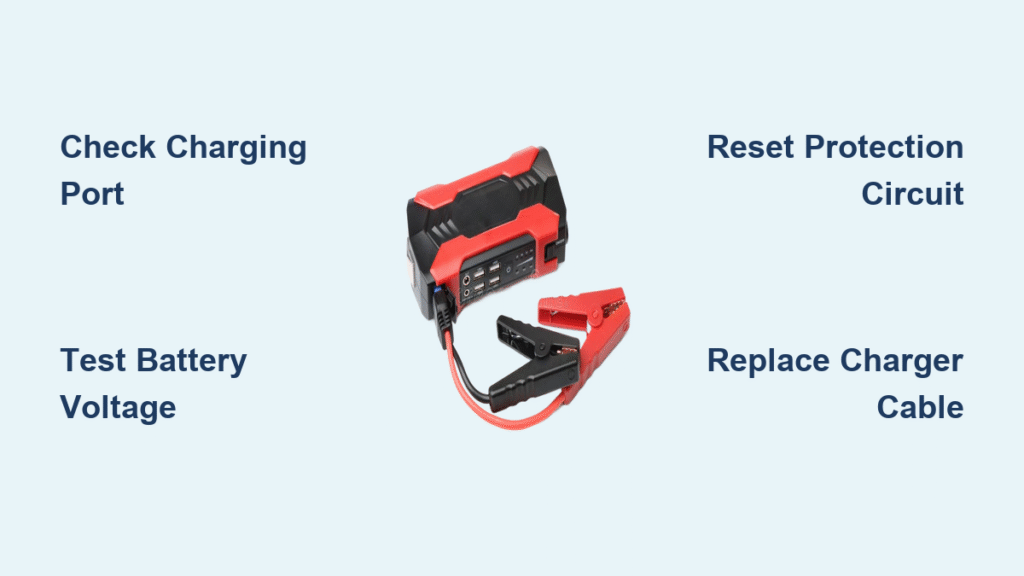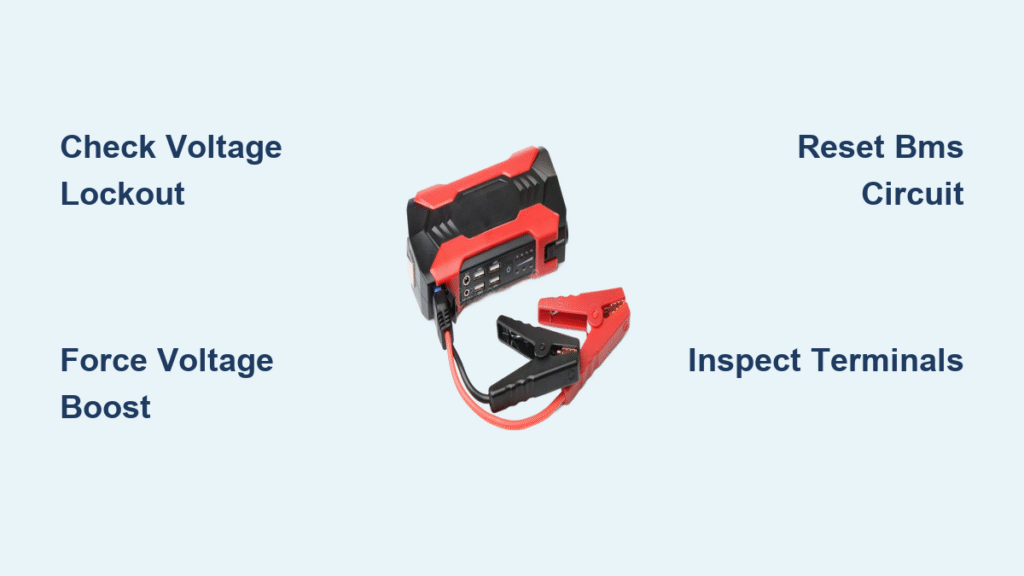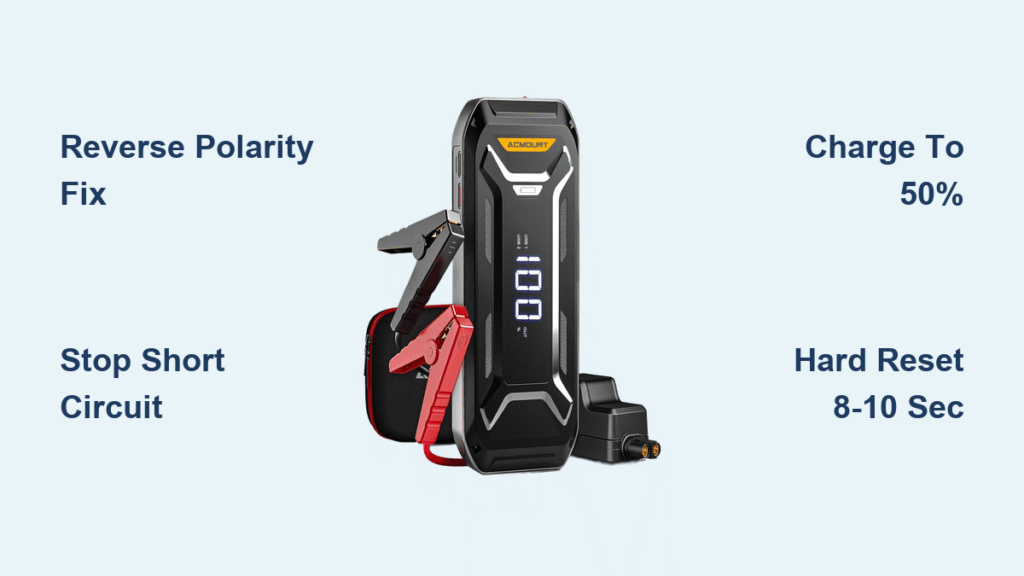That urgent blue glow on your AVAPOW jump starter creates instant panic when you’re stranded with a dead car battery. Instead of the expected green or white power-up sequence, you’re greeted with a persistent blue light that refuses to cooperate. This mysterious indicator leaves many drivers wondering if their emergency power source has failed completely. Understanding what your AVAPOW jump starter blue light actually means separates those who get back on the road quickly from those waiting hours for roadside assistance. This guide reveals exactly why your unit displays blue lights and provides proven solutions to restore functionality in minutes.
When your vehicle won’t start and your jump starter responds with blue signals instead of power, you’re facing one of three critical conditions: dangerous connection issues, depleted internal reserves, or environmental safety triggers. Recognizing these blue light patterns before attempting a jump-start prevents damage to your vehicle’s electrical system and preserves your emergency power source. Most drivers waste precious time trying repeated jump attempts when a simple 30-second diagnostic could solve the problem immediately.
Decoding Your AVAPOW Jump Starter Blue Light Patterns

Your AVAPOW communicates through specific light sequences—each blue pattern tells a different story about what’s happening inside the unit. Learning to read these signals transforms confusing emergencies into manageable situations where you know exactly what action to take.
Solid Blue Light: Ready But Not Connecting
When your AVAPOW emits a steady blue glow during jump-start attempts, it means the unit has sufficient charge but isn’t properly connected to your vehicle’s battery. This common scenario occurs when clamps make contact with corroded terminals or painted surfaces instead of bare metal. The unit detects insufficient conductivity and refuses to engage boost mode as a safety measure. Before assuming your jump starter has failed, verify that both clamps have solid metal-to-metal contact with clean battery terminals.
Rapid Blue Flashing: Reverse Polarity Warning
That frantic blue strobe light means serious trouble—your positive and negative clamps are connected to the wrong battery terminals. This dangerous condition could cause sparks, damage your vehicle’s electronics, or even trigger a battery explosion if power were delivered. Your AVAPOW’s blue flashing serves as a critical safety alert, cutting power until you correct the connection. Never ignore this warning or attempt to bypass the protection system.
Slow Blue Pulsing: Low Power or Temperature Alert
A rhythmic blue pulse indicates either critically low internal charge or unsafe operating temperatures. If your unit has been stored for months without recharging, the internal battery may have dropped below the 25% threshold needed for jump-starting. Alternatively, extreme cold (below 14°F) or heat (above 140°F) triggers automatic shutdowns to protect the lithium battery cells from damage.
Immediate Blue Light Diagnostic Checklist
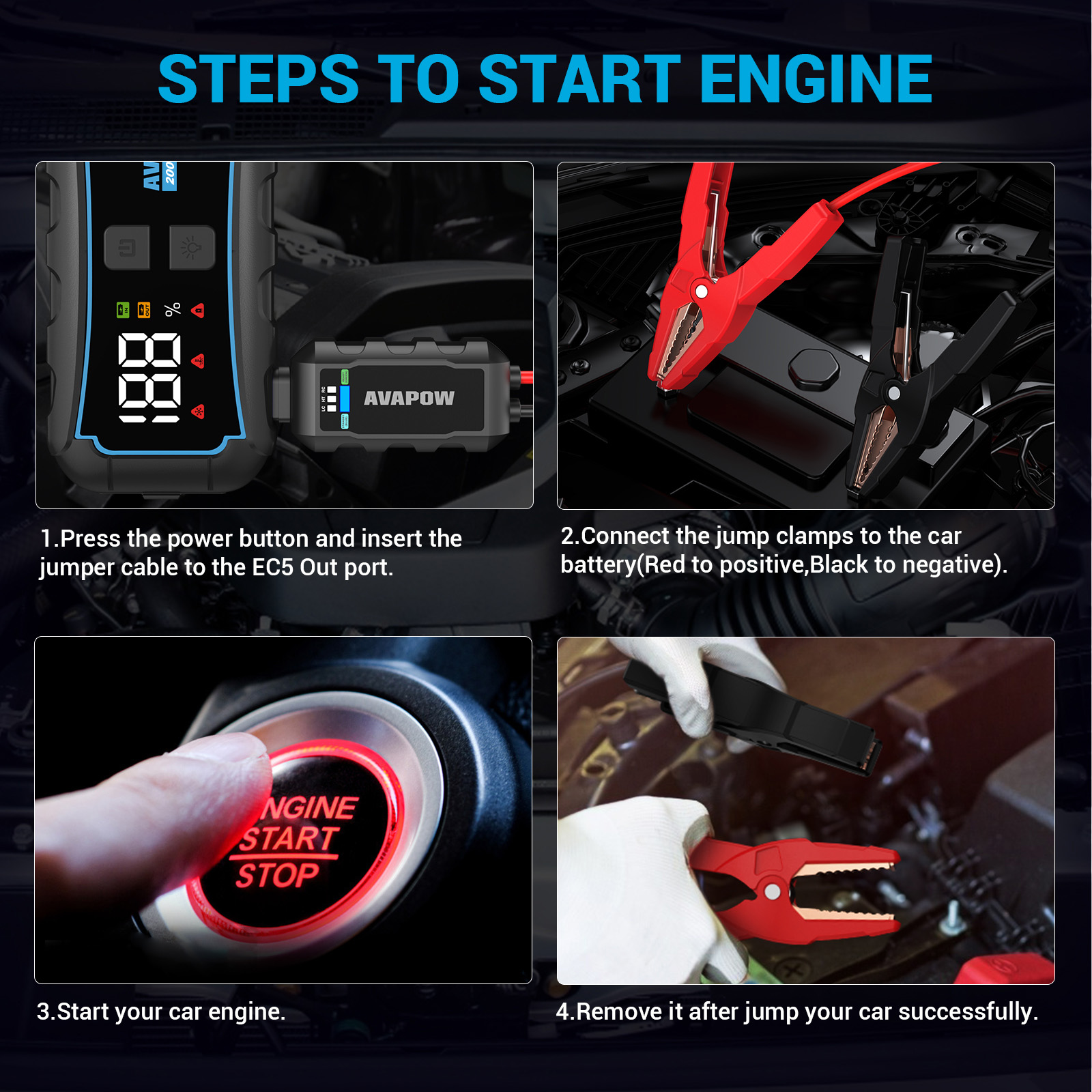
Before replacing your AVAPOW or calling for help, run through these three essential checks that solve 90% of blue light issues in under five minutes.
Verify Connection Points in Daylight
Work in proper lighting to inspect both battery terminals and clamp connections. Look for these common issues:
– Corrosion buildup (white or green powder) on terminals
– Paint or plastic covering terminal surfaces
– Loose clamp attachments that don’t bite into metal
– Damaged cable insulation exposing wires
Clean terminals with a wire brush or terminal cleaner before reattaching clamps. Ensure red clamp connects ONLY to positive terminal (marked “+”) and black ONLY to negative (“-“). Reconnect in this sequence: vehicle positive first, then vehicle negative.
Check Internal Battery Level Accurately
Press the power button once to activate the charge indicator:
– Four solid blue LEDs = 75-100% charge (ready for jump-start)
– Three LEDs = 50-75% (may work for smaller engines)
– Two or fewer = insufficient charge (requires recharging)
If your unit shows adequate charge but still displays blue lights during jump attempts, the issue likely involves connection problems rather than power level.
Assess Temperature Conditions Honestly
Your AVAPOW functions best between 50-104°F (10-40°C). Extreme temperatures trigger automatic safety shutdowns that display blue lights. If you’re working in freezing conditions or scorching heat, move the unit to a moderate environment for 20-30 minutes before retrying. Never attempt to rapidly heat or cool your jump starter—gradual temperature adjustment prevents permanent damage.
Fixing Reverse Polarity Blue Light Issues
When your AVAPOW jump starter blue light flashes rapidly, you’ve connected the clamps incorrectly—a surprisingly common mistake even for experienced mechanics working in low-light conditions.
Step-by-Step Clamp Correction Process
- Immediately disconnect BOTH clamps from the vehicle battery
- Locate the positive terminal (marked “+” with red cover)
- Identify the negative terminal (marked “-” connected to chassis)
- Reconnect RED clamp to positive terminal FIRST
- Attach BLACK clamp to negative terminal SECOND
This sequence prevents dangerous sparks that occur when connecting the final clamp across a completed circuit. After proper connection, the blue flashing should stop within 10 seconds.
Testing for Connection Integrity
After correcting polarity, press the boost button while watching the indicator lights. Solid green or white means proper connection. If blue returns:
– Ensure clamps aren’t touching each other
– Verify terminals are clean and corrosion-free
– Check for damaged cable insulation
– Try connecting negative clamp to engine block instead of battery terminal
For vehicles with recessed battery posts, use terminal adapters to ensure solid metal contact. European models often require connecting clamps to cable ends rather than posts themselves.
Recharging Your AVAPOW After Low Power Blue Light
When blue lights indicate depleted internal batteries, proper recharging restores functionality while preventing permanent damage.
Optimal Charging Procedure

Use ONLY the provided USB-C or micro-USB cable with a standard 5V/2A wall adapter (not your car’s USB port). Connect to power and observe these charging indicators:
– Single LED: 0-25% charge (inadequate for jump-starting)
– Two LEDs: 25-50% (may work for small engines)
– Three LEDs: 50-75% (reliable for most vehicles)
– Four solid LEDs: 75-100% (fully charged)
Complete recharge typically takes 4-5 hours from empty. Rapid blue flashing during charging indicates poor connection—check cable seating at both ends.
Battery Maintenance Best Practices
Preserve your AVAPOW’s longevity with these simple habits:
– Store at 50-75% charge for extended periods
– Recharge every 3-6 months even when unused
– Avoid leaving plugged in continuously after full charge
– Never store in vehicle trunks during extreme temperatures
Lithium batteries degrade fastest when stored completely empty or fully charged for long periods. A monthly charge check prevents unpleasant surprises during emergencies.
Temperature-Related Blue Light Solutions
Extreme weather accounts for 30% of AVAPOW blue light issues—knowing how to respond prevents permanent damage to your emergency power source.
Cold Weather Recovery Protocol
When temperatures drop below freezing:
1. Move unit to warm environment (car interior or building)
2. Allow 30-45 minutes for gradual warming
3. Wipe any condensation before use
4. Attempt jump-start with engine running
Never use external heat sources like hair dryers—rapid temperature changes crack internal components. If your vehicle starts, let it idle for 10 minutes to warm the battery before turning off.
Heat Management Strategies
After exposure to extreme heat:
– Move unit to shade or air conditioning immediately
– Allow 15-20 minutes for cooling
– Check case temperature—should feel cool to touch
– Verify normal operation before attempting jump-start
During summer months, store your AVAPOW in the vehicle cabin rather than the trunk where temperatures can exceed 160°F. An insulated lunch bag provides extra protection against temperature extremes.
Preventing Future AVAPOW Blue Light Emergencies
Proactive maintenance prevents 80% of blue light scenarios before they strand you roadside.
Monthly Readiness Checks
Schedule these simple tests every 30 days:
– Verify charge level shows at least three blue LEDs
– Inspect cables for fraying or exposed wires
– Clean terminal clamps with rubbing alcohol
– Test jump-start capability on your vehicle
This routine identifies issues before emergencies happen. A quick monthly test takes less than two minutes but ensures reliability when you need it most.
Smart Storage Solutions
Maximize your AVAPOW’s lifespan with proper storage:
– Maintain 50-75% charge during storage
– Keep in temperature-controlled spaces (32-80°F)
– Use the included carrying case for protection
– Store away from metal objects that could short terminals
Avoid leaving your jump starter in vehicles during extreme weather—temperature fluctuations degrade battery performance faster than normal use. Consider a dedicated emergency kit inside your home for quick access during critical situations.
Key Takeaways: Your AVAPOW jump starter blue light isn’t a failure—it’s communicating vital information. Most blue light issues resolve through proper connection techniques, adequate charging, or temperature management. When you see blue signals, pause to decode the message before assuming your jump starter has failed. By understanding these visual warnings and following systematic troubleshooting steps, you’ll transform roadside emergencies into quick recoveries. Remember: a flashing blue light means your safety systems are working exactly as designed—respond correctly and you’ll get back on the road faster. Keep this guide accessible in your vehicle and perform monthly checks to ensure your AVAPOW works when you need it most.
